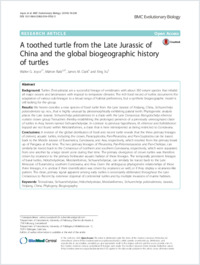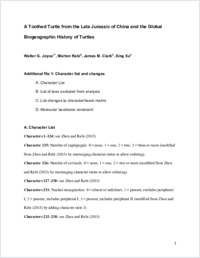A toothed turtle from the Late Jurassic of China and the global biogeographic history of turtles
- Joyce, Walter G. Department of Geosciences, University of Fribourg, Switzerland
- Rab, Márton Department of Geosciences, University of Tübingen, Germany
- Clark, James M. Department of Geosciences, University of Turin, Italy - Department of Biological Sciences, George Washington University, USA
- Xu, Xing Key Laboratory of Vertebrate Evolution , Institute of Paleontology, Chinese Academy of Sciences, Beijing, China
-
2016
Published in:
- BMC Evolutionary Biology. - 2016, vol. 16, p. 236
Testudinata
Sichuanchelyidae
Helochelydridae
Meiolaniforme
s Sichuanchelys palatodentata
Jurassic
Xinjiang
China
Phylogeny
Biogeography
English
Turtles (Testudinata) are a successful lineage of vertebrates with about 350 extant species that inhabit all major oceans and landmasses with tropical to temperate climates. The rich fossil record of turtles documents the adaptation of various sub- lineages to a broad range of habitat preferences, but a synthetic biogeographic model is still lacking for the group.Results: We herein describe a new species of fossil turtle from the Late Jurassic of Xinjiang, China, Sichuanchelys palatodentata sp. nov., that is highly unusual by plesiomorphically exhibiting palatal teeth. Phylogenetic analysis places the Late Jurassic Sichuanchelys palatodentata in a clade with the Late Cretaceous Mongolochelys efremovi outside crown group Testudines thereby establishing the prolonged presence of a previously unrecognized clade of turtles in Asia, herein named Sichuanchelyidae. In contrast to previous hypotheses, M. efremovi and Kallokibotion bajazidi are not found within Meiolaniformes, a clade that is here reinterpreted as being restricted to Gondwana.Conclusions: A revision of the global distribution of fossil and recent turtle reveals that the three primary lineages of derived, aquatic turtles, including the crown, Paracryptodira, Pan-Pleurodira, and Pan- Cryptodira can be traced back to the Middle Jurassic of Euramerica, Gondwana, and Asia, respectively, which resulted from the primary break up of Pangaea at that time. The two primary lineages of Pleurodira, Pan-Pelomedusoides and Pan-Chelidae, can similarly be traced back to the Cretaceous of northern and southern Gondwana, respectively, which were separated from one another by a large desert zone during that time. The primary divergence of crown turtles was therefore driven by vicariance to the primary freshwater aquatic habitat of these lineages. The temporally persistent lineages of basal turtles, Helochelydridae, Meiolaniformes, Sichuanchelyidae, can similarly be traced back to the Late Mesozoic of Euramerica, southern Gondwana, and Asia. Given the ambiguous phylogenetic relationships of these three lineages, it is unclear if their diversification was driven by vicariance as well, or if they display a vicariance-like pattern. The clean, primary signal apparent among early turtles is secondarily obliterated throughout the Late Cretaceous to Recent by extensive dispersal of continental turtles and by multiple invasions of marine habitats.
- Faculty
- Faculté des sciences et de médecine
- Department
- Département de Géosciences
- Language
-
- English
- Classification
- Palaeontology
- License
- License undefined
- Identifiers
-
- RERO DOC 278573
- DOI 10.1186/s12862-016-0762-5
- Persistent URL
- https://folia.unifr.ch/unifr/documents/305409
Other files
Statistics
Document views: 104
File downloads:
- joy_ttf.pdf: 144
- joy_ttf_sm.pdf: 135

